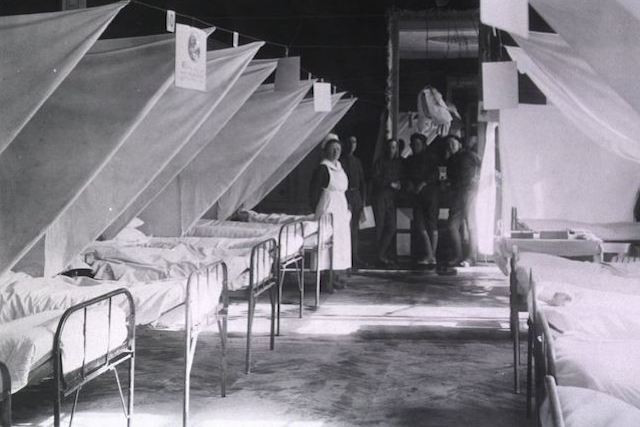Frustratingly for historians, little evidence remains of the impact of Spanish flu in Luxembourg during its two waves in the summer and then autumn of 1918. “One reason is partly due to the military mobilisation at the end of WWI. At that time, Luxembourg was under German occupation. The Spanish flu didn’t make it into the press headlines,” teacher/researcher at the University of Luxembourg’s Centre of Contemporary and Digital history, C2DH, Jacques Maas explains.
Maas did, however, hit on a rich seam of material from the archives of the Arbed steel plant in Dudelange, which examined its workforce during WWI. “At the time, 2,500 people were in the workforce at the plant. A fifth of its workforce fell ill and 18 people died from September to November 1918,” the historian says. The cause of death was given as Spanish flu. Of the 18 fatalities, two were young women aged 16 and 18. Maas said that the plant was so badly struck, it had to partly reduce production.
Arbed introduced its own measures in Dudelange, which included social distancing and hygiene recommendations. There is little evidence masks were used, however. The national response, meanwhile, was sluggish. According to Maas, the state didn’t issue measures until 19 October, when it called for the closure of schools, music halls, theatres and cinemas. Borders remained open and economic and industrial activities were allowed to continue at the discretion of company chiefs.

Photo shows workers at the Dudelange Arbed plant in 1906, 12 years before the pandemic. Photo: Jacques Maas archives.
“It seems as if in some regions of the country, mostly rural areas, there was some kind of resistance against this kind of shut down. Because in October traditionally there were village festivities after the harvest and police had serious problems implementing the orders of public authorities to shut them down,” Maas said.
Approximately 1,000 deaths
While there is no official Spanish flu death toll for Luxembourg, historians estimate that it killed around 1,000 people, based on the annual death figures during the preceding war years compared to 1918. If correct, that meant that almost a fifth of the deaths that year were caused by the Spanish flu.
It is thought it was brought to Luxembourg by troop movements. The First World War came to an end in 1918, Luxembourg soldiers returned from their respective regiments, and both French and US troops were stationed in Luxembourg. The American Army even had a hospital in Walferdange.
Maas has studied media coverage from the time and he says that Spanish flu was one among a series of issues facing the country in 1918. The armistice ending WWI was not signed until 11 November 1918, Luxembourg was emerging from German occupation and, like the rest of Europe, was experiencing political and economic upheavals, with a strong swell of support for communism. Luxembourg workers and rural labourers later formed a communist style soviet and proclaimed a republic. Meanwhile, calls were growing stronger for the then Grand Duchess, Marie Adelaide, to abdicate for her collaboration with the German occupiers.
At the time, there does not appear to be evidence of great resistance against the shutdown measures. It may be because the measures only lasted for a period of several weeks. But Maas suggests this was also because of a scarcity of information at the time, linked to military censorship. “I presume there was not the kind of fear at the time in comparison to the fear in present society. I think for a long time between June and October, most people were not informed,” the historian said

A parade of French troops in Luxembourg City on 22 November 1918 at the end of the second, deadlier wave of Spanish flu. Photo: Wikimedia Commons.
That did not stop the emergence of conspiracy theories. In the same way that today stories claiming coronavirus was manufactured in a laboratory circulate like wildfire, in 1918 the public found an easy answer to a complex problem in blaming the enemy. “There were theories at the end of the war accusing the enemy of having produced the virus deliberately to weaken the old forces,” Maas said. Rumours circulated that German aspirin manufacturer Bayer was somehow responsible--aspirin was prescribed at the time to treat patients.
Today, medical experts suggest the dangerously high dosage of aspirin prescribed to Spanish flu patients may have played a large role in the high death toll.
One hundred years on and, Luxembourg has its own health ministry, something which did not exist at the time of Spanish flu. Its more comprehensive lockdown involving schools and non-essential businesses accompanied by a host of other measures some of which are enforced through fines, has lasted considerably longer than in 1918.
And, there appears to be more global coordination and consensus on containment measures, even if countries are taking unilateral measures on matters such as border closures. Thanks to online media, people have never been better informed, but access to information and publishing platforms while the science is still emerging can also be a curse as well as a blessing.
“As in every difficult situation in society in the past or today, we’ve a difficult economic situation so people are looking for responsibility. The scientific answer isn’t welcomed by every citizen. It’s too difficult to understand. People are looking for an easier explanation,” he says, pointing to the conspiracy theories circulating on social media in Luxembourg. Here, Maas sees the traditional press as playing an important role in the fight against fake news and conspiracy theories.
